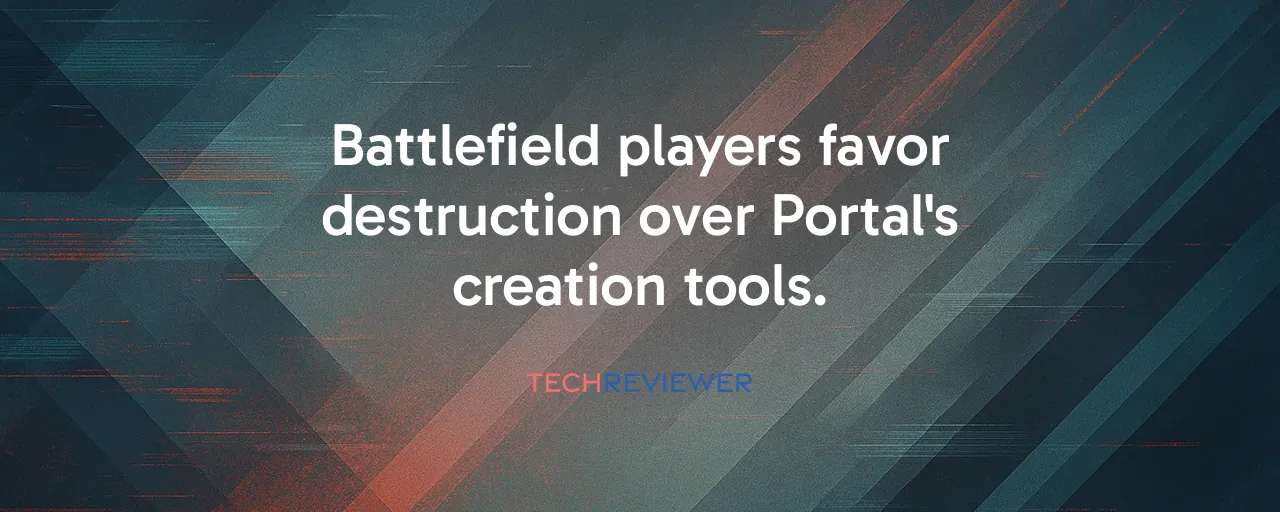A Creative Toolkit Falls Flat
When Electronic Arts unveiled Battlefield 6, its Portal mode promised a playground for player creativity. With tools to craft custom game modes, tweak physics, and build unique experiences, it seemed like a bold step for a franchise known for epic multiplayer battles. Yet a recent EA poll revealed a stark reality: only 12 percent of players are excited about Portal, trailing far behind tactical destruction at 39 percent, the single-player campaign at 30 percent, and standard multiplayer content at 18 percent. This gap raises a question: why does a feature with so much potential struggle to capture the imagination of Battlefield players?
Portal mode lets players dive into a sandbox where they can script game rules, adjust destruction levels, and collaborate in real-time with others. It's a leap from its debut in Battlefield 2042, where it focused on nostalgic remakes of classic maps. Now it's a full-fledged creation suite with over 150 logic blocks for designing everything from team dynamics to custom scoring systems. Despite this, players seem more drawn to the chaos of destructible environments or the return of a gripping campaign. The disconnect suggests a deeper challenge in convincing players to embrace creation over competition.
What Players Really Want
Battlefield has always thrived on visceral, large-scale action. The poll results highlight this, with nearly 40 percent of players buzzing about tactical destruction, a feature refined through Battlefield Labs to deliver jaw-dropping moments like collapsing skyscrapers or shattered bridges. The campaign's return after its absence in Battlefield 2042 also resonates, pulling in 30 percent of the vote with its cinematic storytelling. Meanwhile, Portal's creative tools feel like a side dish to the main course of multiplayer grinding and narrative immersion.
For many players, the appeal of Battlefield lies in immediate gratification: racking up kills, climbing leaderboards, or diving into a story-driven experience. Portal, by contrast, demands time and effort to learn its visual scripting system, even if it's designed to be accessible without coding knowledge. The promise of earning experience points in custom modes is a smart move by DICE, but early predictions suggest players might exploit this for efficient farming rather than crafting innovative experiences. This focus on optimization over experimentation mirrors broader trends in competitive gaming, where progression often trumps creativity.
Lessons From Halo and Mario Maker
To understand Portal's struggles, consider Halo's Forge mode and Super Mario Maker. Halo's Forge, which evolved from a simple object placer in 2007 to a sophisticated scripting tool by Halo Infinite, shows how creation tools can thrive. Forge succeeded by integrating community maps into official playlists, giving creators visibility and players easy access to quality content. Its success hinged on robust discovery systems and developer support, which showcased standout creations and kept the community engaged long after launch.
Super Mario Maker took a different path, simplifying creation to appeal to a broad audience. Nintendo's family-friendly branding and intuitive tools made it easy for anyone to design levels, leading to viral hits shared across social media. However, both platforms faced challenges Portal now echoes: Forge struggled with a steep learning curve, while Mario Maker battled content overload, where low-effort levels drowned out gems. Battlefield's Portal risks similar pitfalls, with its complex tools deterring casual players and discoverability issues potentially burying great creations.
Bridging the Creativity Gap
Portal's low polling numbers don't spell doom, but they signal a need for better integration. DICE might take cues from Halo by curating top Portal creations and featuring them in official rotations, making them accessible to players who don't create. Streamer partnerships could also amplify visibility, as creators showcase wild modes like custom tournaments or chaotic physics experiments. Without strong discovery systems, Portal risks becoming a niche tool for a small group of dedicated modders rather than a vibrant community hub.
Another hurdle is the learning curve. While visual scripting lowers barriers, it still demands logical thinking and patience, which may not appeal to players chasing quick wins. Tutorials and guided onboarding could help, drawing inspiration from Mario Maker's approachable design. EA also faces the challenge of justifying Portal's hefty development costs, especially when server resources for user-generated content compete with official modes. Balancing creative freedom with competitive integrity, like preventing experience points farm abuse, will be crucial to maintaining trust.
A Long Game for Longevity
Portal's true value might emerge over time. As players exhaust Battlefield 6's core content, the ability to craft new experiences could keep the game alive between updates. Historically, Battlefield's modding community, from Desert Combat in 1942 to Project Reality in Battlefield 2, extended the franchise's lifespan through player creativity. Portal has the tools to revive that spirit, but only if EA invests in community-building and showcases the best creations.
Looking ahead, Portal could evolve into a platform for more than just Battlefield. Imagine cross-franchise modes pulling in assets from other EA games, creating unique crossover experiences. Collaboration with esports groups or educational programs could also unlock new uses, from custom training scenarios to game design workshops. For now, Portal's 12 percent interest suggests it's a gamble that hasn't paid off yet, but with the right tweaks, it could still become a cornerstone of Battlefield's future.
